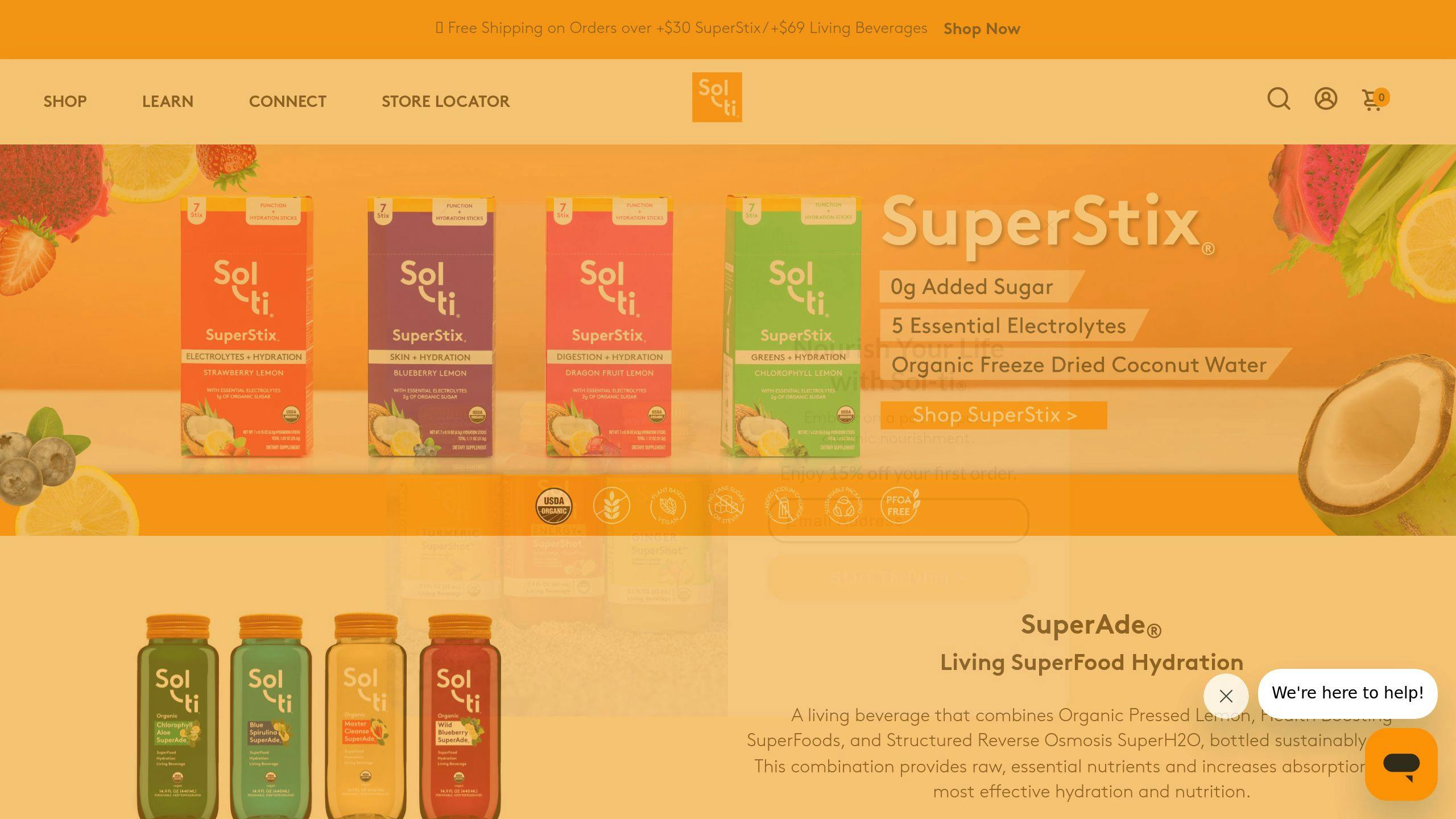Packaging waste makes up 40% of municipal waste in the U.S. Switching to eco-friendly packaging can reduce this significantly while saving resources like water, oil, and trees. Here’s what you need to know:
- Eco-friendly packaging uses renewable, recyclable, or biodegradable materials like glass, paper, and bioplastics.
- Smarter designs reduce waste and emissions with lightweight, multi-functional packaging.
- Options include biodegradable materials (e.g., cornstarch, cellulose), compostable materials (e.g., bagasse, mushroom mycelium), and reusable packaging (e.g., glass bottles, aluminum containers).
- Benefits for businesses: lower costs, better brand image, and stronger customer loyalty.
Whether you’re a consumer or a business, small changes in packaging choices can lead to a cleaner, healthier planet. Let’s explore how.
Eco-Friendly Packaging Ideas: Sustainable Packaging Solutions
Main Features of Eco-Friendly Packaging
Eco-friendly packaging combines environmental responsibility with effective product protection. Below are the core features that define this type of packaging.
Renewable and Recyclable Materials
Using materials like glass, paper, and starch-based bioplastics reduces dependency on finite resources. Starch-based bioplastics, made from sources like corn, potatoes, and tapioca, offer an alternative to petroleum-based plastics [3]. Similarly, cellulose-based films are not only transparent and breathable but also biodegradable, helping keep products fresh while minimizing waste [3]. Opting for these materials is a step toward reducing environmental impact.
Waste Reduction Through Smarter Design
Well-thought-out packaging design can significantly cut down waste. For instance, molded pulp packaging, created from recycled paper and cardboard, provides effective shock absorption with minimal environmental impact [2].
| Design Feature | Environmental Benefit | Practical Application |
|---|---|---|
| Efficient Design | Reduces resource use and emissions | Lightweight, stackable containers |
| Multi-functional Design | Eliminates extra packaging needs | Shipping containers that double as displays |
These innovations allow businesses to streamline their packaging while being more environmentally conscious.
Minimizing Environmental Damage
Eco-friendly packaging prioritizes materials that naturally decompose without harming the environment. Options like bagasse (sugarcane fiber) and cornstarch-based materials break down quickly compared to traditional packaging, which can take decades [2].
A standout example is mushroom mycelium, which offers a durable, fully biodegradable option. Companies like Ecobliss Retail have embraced this material to create packaging that protects products while leaving no harmful residues [3].
Common Types of Eco-Friendly Packaging
Here are some of the most common eco-friendly packaging options available today.
Biodegradable Materials
Biodegradable packaging breaks down naturally over time, helping to reduce waste in landfills. Popular options include starch-based bioplastics, which we've touched on before.
| Material Type | Source | Breakdown Time | Best Use Case |
|---|---|---|---|
| Cornstarch-based | Corn | 3-6 months | Takeout food containers |
| Plant-based plastics | Various crops | 6-12 months | Retail product packaging |
| Cellulose films | Wood pulp | 1-3 months | Perishable wrapping |
Compostable Materials
Compostable packaging not only decomposes fully but also turns into nutrient-rich material that improves soil. Examples like bagasse and mushroom mycelium are standout choices. Mushroom mycelium packaging, for instance, is grown around agricultural byproducts to create custom-shaped containers that rival synthetic foams in durability [2][3]. Look for certified compostable labels to ensure proper disposal.
Reusable Packaging Options
Reusable packaging, such as glass bottles, is a practical way to cut waste. Brands like Sol-ti lead the way with their UV Light Filtered™ process, which keeps products fresh while allowing bottles to be reused.
Aluminum containers are another strong contender. They're lightweight, endlessly recyclable, and require fewer resources to produce. Reusable options like these can make a big difference - recycling just one ton of paper saves 17 trees, 380 gallons of oil, and 7,000 gallons of water [2][4].
Why Choose Eco-Friendly Packaging?
Switching to eco-friendly packaging isn't just about helping the environment - it can also benefit your business in meaningful ways. Here's why making the shift makes sense.
Helping the Planet
Eco-friendly packaging helps reduce waste and conserve resources by using materials that are biodegradable, compostable, or recyclable. These materials break down naturally, avoiding the release of harmful chemicals into the environment [1]. Choosing such packaging also cuts down on landfill waste and lowers greenhouse gas emissions. Beyond helping the planet, these choices can also bring financial and reputational advantages.
Saving Money and Growing Business
Though the initial costs of eco-friendly packaging may be higher, it often pays off in the long run. Here's how:
| Cost Factor | Benefit | Impact |
|---|---|---|
| Transportation & Storage | Lighter, space-saving materials | Lower shipping and storage costs |
| Material Efficiency | Smart, efficient designs | Reduced material and waste expenses |
| Market Growth | Sustainable practices | Improved sales and customer loyalty |
Eco-conscious consumers are drawn to brands that prioritize sustainability, which can lead to stronger sales and lasting customer relationships [1][5].
Building a Positive Reputation
Sustainable practices resonate strongly with Millennials and Gen Z, who often prefer brands that align with their values. This makes eco-friendly packaging a key factor in building customer loyalty and enhancing brand image [1]. Even employees tend to feel more engaged and motivated when working for companies that prioritize sustainability. According to the Environmental Protection Agency (EPA), businesses that adopt sustainable packaging often see a boost in their brand perception [2].
To fully leverage these advantages, businesses should:
- Evaluate their current packaging to identify areas for improvement.
- Work with trusted suppliers who offer certified eco-friendly materials.
- Monitor progress by tracking reductions in waste and energy use.
- Share their efforts openly with customers and stakeholders.
sbb-itb-74fe2fe
How to Start Using Eco-Friendly Packaging
Tips for Individuals
Making the switch to eco-friendly packaging starts with simple, thoughtful steps. When shopping, prioritize products with certifications like FSC, USDA Organic, or Cradle to Cradle. Also, opt for items with minimal packaging.
Here are some practical swaps you can make:
| Shopping Habit | Eco-Friendly Alternative | Positive Impact |
|---|---|---|
| Using single-use plastic bags | Beeswax wraps | Cuts down on plastic waste |
| Buying individually packaged items | Purchasing in bulk | Reduces packaging waste |
| Relying on disposable containers | Glass or steel containers | Eliminates single-use waste |
Familiarize yourself with your local recycling rules to ensure your choices align with them. While these personal changes matter, businesses have a much bigger influence in promoting eco-friendly packaging on a larger scale.
Steps for Businesses
For businesses, adopting eco-friendly packaging requires careful planning and execution. Start by auditing your current packaging practices to identify areas for improvement.
1. Assessment Phase
Document your current materials, costs, and their impact on the environment to establish a clear starting point.
2. Supplier Selection
Collaborate with suppliers who specialize in eco-friendly options. Look for those offering:
- Certified sustainable materials
- Detailed environmental impact information
- Creative packaging solutions
- Competitive pricing
3. Material Testing
Test alternative materials on a smaller scale to see how they perform, gauge customer reactions, and evaluate costs.
The biodegradable packaging market provides a variety of options, such as nano-cellulose, plant-based proteins, and starch-based bioplastics. Each material offers unique benefits depending on your product and business needs.
Finally, educate your team about the importance of these changes and their role in the process. Embracing sustainable practices not only helps the environment but can also boost cost-efficiency and improve your brand's image.
Examples of Eco-Friendly Packaging in Use
Sol-ti: Glass Bottles for Organic Drinks

Sol-ti packages its organic beverages in 100% recyclable glass bottles, combining environmental responsibility with product quality. Glass offers some clear benefits:
| Feature | Environmental Impact | Business Advantage |
|---|---|---|
| Fully Recyclable | Maintains quality through recycling | Boosts eco-conscious brand image |
| Free of Chemicals | Keeps products fresh without additives | Ensures better flavor retention |
| Durable | Cuts down on transport waste | Lowers costs from breakage |
Switching to Compostable Packaging: A Case Study
Ecovative provides a practical alternative to conventional packaging with their mycelium-based products [4]. Their approach shows how businesses can successfully transition to compostable options:
1. Material Development Phase
- Designed mycelium-based materials using agricultural byproducts.
- Created packaging that naturally breaks down over time.
2. Implementation Results
- Fully decomposes within 45-90 days.
- Reduced waste from packaging materials.
- Strengthened brand image as eco-conscious.
"The transition to compostable materials represents more than just environmental responsibility - it's about creating a sustainable business model that benefits both our planet and our bottom line", says an Ecovative representative [2].
From smaller brands like Sol-ti to global leaders like IKEA, the shift to sustainable packaging is gaining momentum. IKEA, for instance, plans to use 100% renewable or recycled packaging by 2030, with biodegradable cellulose films already being implemented.
These examples highlight how businesses of all sizes can align with environmental goals while strengthening customer loyalty and enhancing their overall brand image.
Conclusion: Choosing Better Packaging for the Future
The examples of Sol-ti and Ecovative highlight how thoughtful packaging choices can make a real difference for the planet. Businesses and individuals can help reduce waste and conserve resources by making smarter decisions about the materials they use.
Switching to renewable packaging materials helps cut landfill waste and greenhouse gas emissions, aligning with global efforts to protect the environment. The EPA emphasizes that using renewable materials and improving recycling systems are key steps in tackling packaging-related waste [2].
By embracing new materials and methods, like bagasse and chitosan, we can find practical solutions for packaging food and other goods. These materials show how technology is opening up more sustainable options.
"The widespread adoption of sustainable packaging practices can significantly reduce waste, lower carbon emissions, and protect natural resources. It can also influence consumer behavior and encourage more environmentally friendly practices across industries."
Support companies that prioritize sustainability, reduce your packaging waste, and share knowledge to amplify the impact. Making informed choices today can lead to a cleaner, healthier planet tomorrow.
FAQs
Here, we address some common questions to guide you in making better choices about eco-friendly packaging.
How do I pick eco-friendly packaging?
Opt for packaging that can break down naturally, be recycled, or used multiple times. Materials like cornstarch and bagasse decompose over time, while recyclable options can be turned into new products. Reusable packaging, on the other hand, helps cut waste completely. Look for certifications that verify eco-friendly practices and simple packaging designs that require fewer materials.
What are the most eco-friendly options for beverages and liquids?
Glass is often considered the best option because it can be recycled endlessly, is long-lasting, and doesn’t contain harmful chemicals. Other alternatives include:
| Container Type | Benefits |
|---|---|
| Glass | Fully recyclable, durable, preserves product quality |
| Aluminum | Easy to recycle, lightweight, good for transport |
| Paperboard | Sourced responsibly, uses plant-based coatings |
The EPA highlights that glass packaging not only reduces waste but also keeps products fresh and intact [2]. For businesses aiming to lessen their environmental footprint, glass containers strike a balance between sustainability and meeting customer needs.


